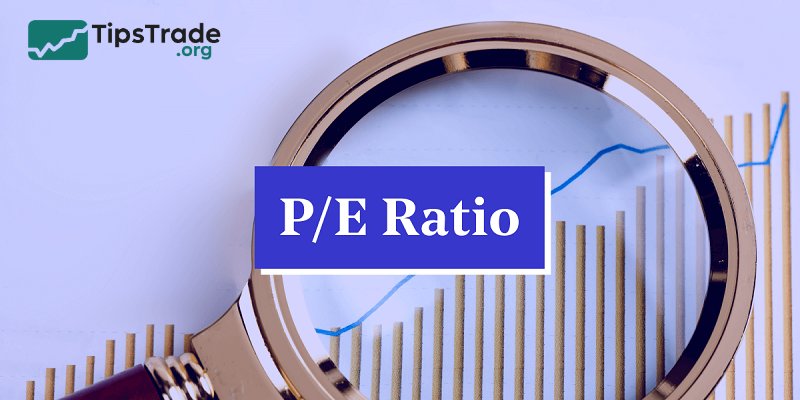The P/E ratio is considered one of the key metrics that helps investors select good stocks. So what exactly does the basic P/E ratio mean? Is a low or high P/E ratio better? Let’s explore the answers with Tipstrade.org in the article below!
What is P/E ratio?
The P/E ratio, short for Price-to-Earnings Ratio, is a financial metric used to assess the relationship between a stock’s market price (Price) and the earnings generated per share (EPS). The Price-to-Earnings ratio is considered an important ratio for valuing stocks. A lower ratio may suggest that the stock is undervalued, and vice versa.

>>See more:
- Understanding Solvency Ratios: Types and Their Importance
- Profitability Ratio – Meaning, Types, Uses and Calculation
- Market Ratios: Understanding Their Significance and Calculation
- What are Liquidity Ratios? 3 Liquidity Ratios You Should Know
P/E ratio formula
Price-to-Earnings (P/E) ratio formula is:
Price-to-Earnings ratio = Price per Share / Earnings per Share
Where:
- Price per share is the current market price of a single share of the company.
- Earnings per share represent the company’s total earnings divided by the number of outstanding shares.
Why is the P/E ratio important?
The Price-to-Earnings ratio is important because it is a valuation metric that is useful for comparing different investment opportunities to one another. It can be a useful tool when trying to identify undervalued stocks, and it can help you avoid overpaying for stocks as well.

Types of P/E ratio
Depending on the perspective of analysis, investors can flexibly choose one of the two common Price-to-Earnings ratios or combine them for a more comprehensive view of the company:
Trailing P/E ratio
Trailing P/E, also known as the Price-to-Earnings ratio based on past earnings, is calculated using a company’s net income over the most recent 12 months. This is the most common type of the Price-to-Earnings ratio, as it accurately reflects the actual profits the company has generated, helping investors gain a clearer understanding of the company’s current performance. However, since it relies on historical data, the Trailing P/E cannot capture future growth expectations, especially for companies with highly volatile earnings.
Formula:
Trailing P/E Ratio = Current share price/EPS of the past 12 months
Forward P/E ratio
Forward P/E, also known as the Price-to-Earnings ratio based on projected earnings, is estimated by dividing the current stock price by the expected earnings per share (EPS) over the next 12 months. Forward P/E provides investors with insight into potential future profitability, which is especially useful for fast-growing companies. However, since this ratio relies on earnings forecasts, it may be inaccurate if the projections do not accurately reflect the company’s actual performance.
Formula:
Forward P/E Ratio = Current share price/Estimated EPS for the next 12 months
Additionally, investors should understand:
- If Forward P/E < Trailing P/E, it indicates that investors expect the company’s earnings to increase in the future.
- If Forward P/E > Trailing P/E, it reflects investors’ expectations that earnings may decline compared to the current level.
Is a low or high P/E ratio better?
The Price-to-Earnings ratio does not have a fixed value that can be considered “good” or “bad,” as it depends on the industry, the company’s business performance, and the overall market context. However, below are some general guidelines to help you understand the meaning of this ratio:
High P/E
A high Price-to-Earnings ratio indicates investors’ optimistic expectation that earnings from that stock will be higher in the future. They believe the company has growth potential, so they are willing to pay a large sum for each dollar of profit from the company.
Conversely, it’s also possible that the stock price has risen too quickly compared to the growth rate of business profits, pushing the Price-to-Earnings Ratio ratio up. In this case, the stock price may have been overinflated.
A high Price-to-Earnings ratio has the following possibilities:
- The company’s stock is overvalued.
- Business prospects for the future are promising.
- The profit is small but only temporary.
- The business is at the bottom of the business cycle.
- The market price is increasing too quickly compared to the increase in profits.

Low P/E
In most cases, a low Price-to-Earnings ratio indicates that a stock is undervalued compared to its intrinsic value. A high EPS is one positive reason that leads to a low Price-to-Earnings ratio. When a company begins to operate more efficiently, its EPS increases and the Price-to-Earnings ratio declines. Therefore, you may consider investing in such stocks.
However, a low Price-to-Earnings ratio can stem from various other reasons. For example, unusual profits (such as asset sales or liquidation) can cause earnings to spike suddenly, pushing EPS higher. Alternatively, negative developments within the company may prompt shareholders to rush to sell, causing the stock price to fall and the Price-to-Earnings ratio to drop accordingly.
In such cases, even though the Price-to-Earnings ratio is low, the stock may not truly be considered cheap, as the company’s prospects may no longer be promising.
Possible scenarios behind a low Price-to-Earnings ratio include:
- The company’s stock is genuinely undervalued.
- The company is experiencing unexpected or one-off profits.
- The business is facing financial or operational difficulties.
- The company is at the peak of its business cycle.
Advantages and disadvantages of the P/E ratio
Similar to other financial indicators, the Price-to-Earnings ratio also has certain advantages and disadvantages that investors need to be aware of:
Advantages of the P/E ratio
The Price-to-Earnings ratio is one of the most widely used tools for stock selection. It is popular because of the following strengths:
- Simple and easy to calculate or look up.
- Combines both the company’s intrinsic value (EPS) and market sentiment (Price).
- Serves as an effective indicator of market psychology.
Disadvantages of the P/E ratio
- When the Price-to-Earnings ratio is negative, it becomes meaningless for evaluating a stock.
- The quality of the Price-to-Earnings ratio is influenced by various factors from both the market and the company. Stock prices can become distorted when the market is unstable. EPS may also fluctuate if a company intentionally inflates or reduces profits to serve its own purposes.
Final thoughts
Above, Tipstrade.org has provided you with the most detailed and comprehensive information about the P/E ratio. This is one of the key metrics that helps investors value stocks in a simple and effective way. Although it is not a perfectly flawless metric, the Price-to-Earnings ratio is considered a powerful tool that can support you in making more informed and effective investment decisions.
See more:

